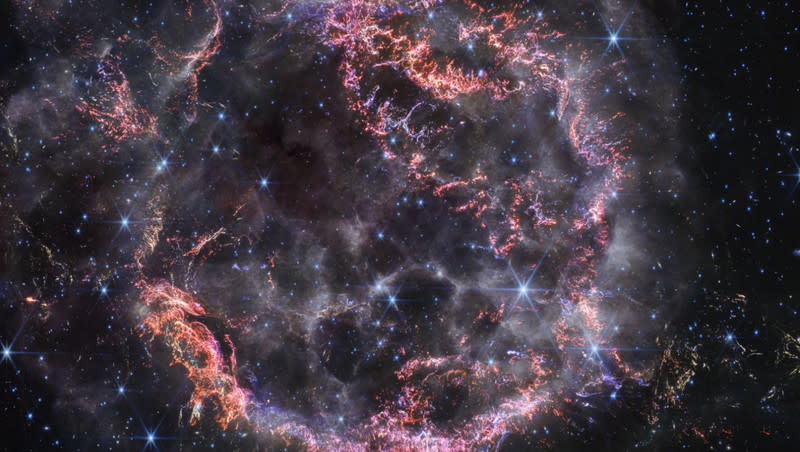Stunning images of supernova space ‘ornament’ captured by NASA’s Webb Telescope

Featured in the first-ever White House Advent Calendar for the 2023 holidays, a new image captured by NASA’s James Webb Space Telescope reveals never-before-seen details in the remnants of a massive exploded star that is the youngest known supernova in the Milky Way Galaxy.
“Like a shiny, round ornament ready to be placed in the perfect spot on a holiday tree,” NASA said the images of Cassiopeia A captured by Webb’s near-infrared cameras reveal intricate details of the expanding shell of material slamming into the gas shed by the star before it exploded.
Cassiopeia A is located in the Cassiopeia constellation some 11,000 light years from Earth. Light from the supernova event, the youngest known remnants in our galaxy, first reached Earth 340 years ago and is one of the most-studied space phenomena.
To: You, From: The Universe 🎁
This stunning new Webb image is a gift from a past star. In near-infrared light, supernova remnant Cassiopeia A (Cas A) resembles a shiny ornament. Embedded within gas from the star are the materials for new stars & planets: https://t.co/9kIvQtEnpb pic.twitter.com/vzzaWrzPBA— NASA Webb Telescope (@NASAWebb) December 11, 2023
The U.S. space agency reports various, multi-wavelength images of supernova remnants have been gathered over the years by ground-based and space-based observatories, including NASA’s Chandra X-Ray Observatory, Hubble Space Telescope and retired Spitzer Space Telescope.
But, the Webb Telescope’s razor-sharp infrared equipment can detect the tiniest knots of gas, comprised of sulfur, oxygen, argon and neon from the star itself. While the infrared spectrum is invisible to our sight, image processors and scientists translate these wavelengths of light to visible colors.
“With NIRCam’s resolution, we can now see how the dying star absolutely shattered when it exploded, leaving filaments akin to tiny shards of glass behind,” Danny Milisavljevic of Purdue University, who leads the research team, said in a NASA blog post. “It’s really unbelievable after all these years studying Cas A to now resolve those details, which are providing us with transformational insight into how this star exploded.”
Related
Earth strikes back: NASA successfully crashes spacecraft into asteroid in planetary defense test
James Webb Space Telescope turns its high-tech ‘eyes’ on Mars
NASA scientists say the most noticeable colors in Webb’s newest image are clumps represented in bright orange and light pink that make up the inner shell of the supernova remnant. Embedded in this gas is a mixture of dust and molecules, which will eventually become components of new stars and planetary systems. Some filaments of debris are too tiny to be resolved by even Webb, according to NASA, meaning they are comparable to or less than 10 billion miles across.
“We’ve never had this kind of look at an exploded star before,” astronomer Dan Milisavljevic, assistant professor of physics and astronomy at Purdue University, said in a statement shared with CNN. “Supernovae are primary drivers of cosmological evolution. The energies, their chemical abundances — there is so much that depends on our understanding of supernovae. This is the closest look we’ve had at a supernova in our galaxy.”
While the Hubble Space Telescope, launched into low-Earth orbit in 1990, “sees” objects in the optical and ultraviolet spectrums, with some limited infrared capabilities, the Webb telescope is optimized for looking at the universe via the infrared spectrum. The Webb telescope also has a much larger mirror than the Hubble, which collects more light and is able to peer farther back in time than the Hubble is capable of doing.
The $10 billion Webb telescope is an international collaboration that includes NASA, the European Space Agency and the Canadian Space Agency. It launched into space on Christmas Day 2021 atop a European Ariane 5 rocket and traveled to a position 1 million miles from home, where it is orbiting the sun.
While the first Webb images were transmitted back to earth in July 2022, where the data is picked up by ground-based antennas in Australia, California and Spain, the Hubble is still in operation and making observations from its position about 340 miles above Earth. Hubble launched with an expected lifespan of about 15 years, but NASA scientists say it could continue operating until the late 2020s.

